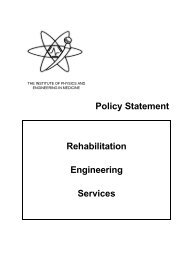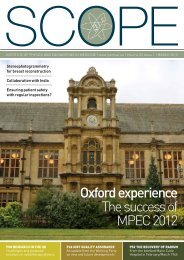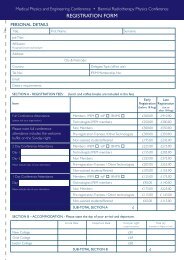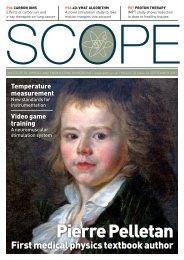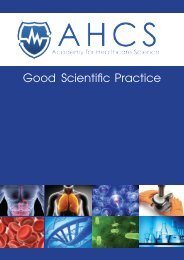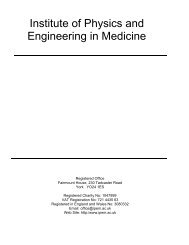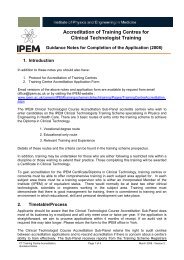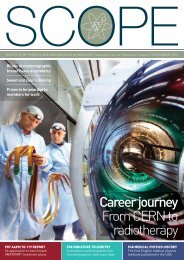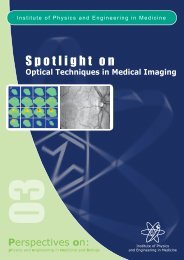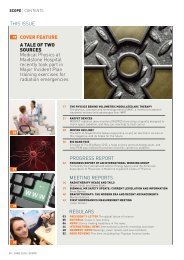Guidance for Part I Trainees taking Physiological Measurement
Guidance for Part I Trainees taking Physiological Measurement
Guidance for Part I Trainees taking Physiological Measurement
You also want an ePaper? Increase the reach of your titles
YUMPU automatically turns print PDFs into web optimized ePapers that Google loves.
Institute of Physics & Engineering in Medicine<br />
<strong>Guidance</strong> <strong>for</strong> <strong>Part</strong> 1 <strong>Trainees</strong> <strong>taking</strong><br />
<strong>Physiological</strong> <strong>Measurement</strong><br />
1. The <strong>Part</strong> 1 <strong>Physiological</strong> <strong>Measurement</strong> competencies were written to accommodate the wide range<br />
of measurements and techniques that may be studied. As a consequence, the advice given as to<br />
the standard expected may be variable. The following guidance has been prepared by the IPEM<br />
Examiners <strong>for</strong> <strong>Physiological</strong> <strong>Measurement</strong>, and is offered to help improve the first-time pass rate in<br />
this subject.<br />
2. The portfolio must provide evidence that all the required competencies have been met. Otherwise,<br />
an examiner has to satisfy him/herself during the viva that you have the competencies which are not<br />
fully met in the portfolio.<br />
3. Make sure you include a table or other means of listing the required competencies that crossreferences<br />
where in the portfolio the evidence <strong>for</strong> each competency is located.<br />
4. Competencies PM 1.1 and PM 1.2 are different. PM 1.1 requires that you demonstrate a broad<br />
understanding of the (1) principles, (2) relevant physiology, and (3) measurement significance of<br />
common physiological measurement procedures.<br />
5. PM 1.2 requires that you demonstrate a detailed understanding of the (1) principles, (2) relevant<br />
physiology and (3) measurement significance of three selected parameters.<br />
6. A broad understanding of common physiological procedures implies a less-detailed understanding<br />
is expected than <strong>for</strong> the three selected <strong>for</strong> PM 1.2. Common physiological measurements would be<br />
expected to include non-invasive blood pressure measurement and ECG. Short term<br />
acquaintanceships, in addition to your three main areas, are ideally suited to PM 1.1.<br />
7. In PM 1.1, it is mandatory that among the physiological measurements covered, at least one must<br />
be a pressure measurement, one a flow measurement and one must be electrophysiological.<br />
8. The principles of a physiological measurement procedure would include knowledge of how the<br />
relevant transducers (or electrodes) convert a physical measurement or event into a signal that can<br />
be amplified, processed and displayed and, where appropriate, how that signal would be affected by<br />
transducer position, patient orientation, environmental or other relevant factors.<br />
9. The relevant physiology should put the measurement into a clinical context – why it is done, what is<br />
the physiological state or change that is to be detected, how does that relate to the physical event<br />
detected or measurement actually made (including limitations or assumptions that have to be<br />
made).<br />
10. The measurement significance is expected to include both statistical and clinical significance of the<br />
measurement and the extent to which it affects further patient management.<br />
11. Additional detail required <strong>for</strong> PM 1.2 is given by PM 1.2.1 – 1.2.6. All six aspects must be covered<br />
<strong>for</strong> each measurement, unless clearly non-applicable in some specific case. It is accepted that the<br />
amount of detail given to each of PM 1.2.1 – 1.2.6 will vary between the three selected<br />
measurements. The following suggestions are given as to how these competencies might be<br />
achieved.<br />
12. To identify and justify the choice of equipment, you could ask questions such as: Are there<br />
alternatives What are the pros and cons of the various options Is the method used the best<br />
possible Why was this particular technology/manufacturer/model chosen Why is a particular<br />
transducer/ electrode/sensor used Why is the particular electrode/transducer/etc placed where it<br />
is What is its sensitivity pattern within the body How accurately does it have to be positioned<br />
Could the in<strong>for</strong>mation be obtained from a different position Are there advantages/disadvantages of<br />
different positions<br />
Clinical Scientists' Education and Training Panel<br />
June 2009<br />
1 of 2<br />
<strong>Guidance</strong> <strong>for</strong> <strong>Part</strong> 1 <strong>Trainees</strong><br />
<strong>Physiological</strong> <strong>Measurement</strong>
13. Hands-on experience is essential. The trainee should actively contribute to the patient<br />
measurement wherever possible and ethical. In most cases, training can progress to “push buttons”<br />
under supervision, or to use the equipment on a normal volunteer, or a test phantom. Where this is<br />
not possible, hands-on experience of using the equipment can be obtained by allowing the trainee<br />
to per<strong>for</strong>m a calibration check or similar.<br />
14. <strong>Trainees</strong> should understand how the signal can be modified at each step from the actual<br />
physiological change to the final recording or measurement. This might include concepts such as<br />
transducer sensitivity patterns, transfer functions, resonance frequencies, phase changes, analogue<br />
and digital filters and any other signal processing technique appropriate to the measurement. A<br />
trainee should also know about possible interfering signals, where these might come from and how<br />
they can be minimised.<br />
15. <strong>Trainees</strong> are expected to understand the limitations of the measurements made in terms of<br />
measurement uncertainty, assumptions made, discrepancies between what is actually measured<br />
and what, ideally, is wanted. Sources of artefact and how these might be recognised should be<br />
understood. <strong>Measurement</strong>s should be accompanied by an estimate of the uncertainty and, where<br />
appropriate, the rationale <strong>for</strong> that estimate. A scientist at this level should never report<br />
measurements with an unjustifiable number of significant figures!<br />
16. The statistical methods used will depend on the context of the three parameters studied in detail, so<br />
no list will be given of what methods a trainee must know. However, an understanding is expected<br />
of the concepts of normal ranges and thresholds and how these are obtained. The significance or<br />
otherwise of measurements close to these threshold(s) should be understood, as should type I and<br />
type II errors.<br />
17. Where routine calibration checks are automatic processes, these are not acceptable <strong>for</strong><br />
demonstrating competency PM 1.2.5. Calibrations must be per<strong>for</strong>med with external standards of<br />
pressure, flow, voltage, current or whatever. An understanding would be expected of calibration<br />
standards, offset, linearity, hysteresis, drift and repeatability, and how these affect accuracy and<br />
precision.<br />
18. Where appropriate, the trainee should be involved in reporting. Portfolios might include trial patient<br />
reports written by the trainee at the time, possibly with a discussion of any discrepancy with the<br />
report actually issued. Otherwise, anonymous case studies could illustrate a clinical problem,<br />
discuss how the physiological measurement contributes to patient management and, where<br />
possible, discuss the outcome in the particular case.<br />
19. Electrical safety tests of medical equipment are often automated but the trainee should have a<br />
broad understanding of what these measure, and why. They should have some knowledge of:<br />
20. the general concept of safety in a single fault condition and the need <strong>for</strong> regular maintenance or<br />
other means to identify a single fault state,<br />
21. what a leakage current is,<br />
22. what the symbols mean, that most commonly appear on the outside of a medical device,<br />
23. what an applied part is and what the designations B, BF and CF signify,<br />
24. the basic principles of electrical safety as applied to medical electrical systems, and as applied to<br />
multiple devices connected to the same patient.<br />
25. about the system <strong>for</strong> reporting adverse incidents to the MHRA.<br />
26. The trainee should know about the Medical Devices Directive, what is its purpose, what the CE<br />
mark signifies and the role of the MHRA as the Competent Authority in the UK.<br />
27. The trainee would be expected to know about standards and guidelines relevant to the parameters<br />
studied in PM 1.2.<br />
Dr Steve Pye<br />
Chief Examiner<br />
3 rd June 2009<br />
Clinical Scientists' Education and Training Panel<br />
June 2009<br />
2 of 2<br />
<strong>Guidance</strong> <strong>for</strong> <strong>Part</strong> 1 <strong>Trainees</strong><br />
<strong>Physiological</strong> <strong>Measurement</strong>



